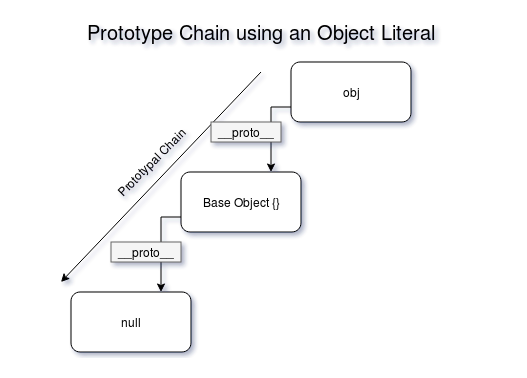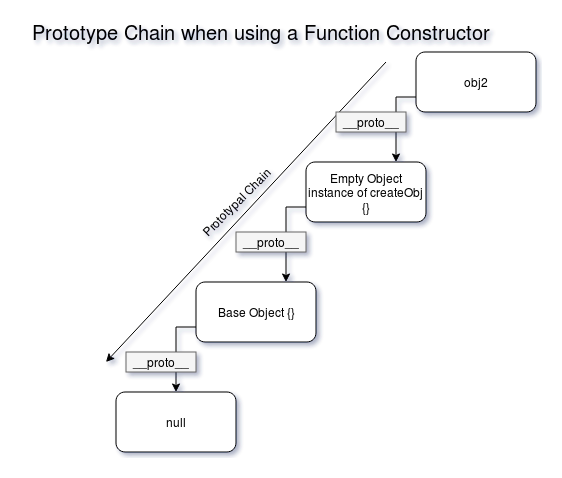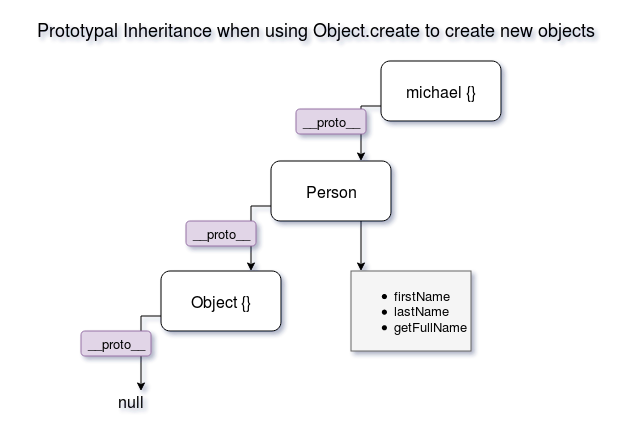What are the different ways to create an object?
Object Literal Syntax
var obj = {
prop1: 1,
prop2: 2,
method1: function() {
return this.prop1;
}
}
console.log(obj.__proto__);
console.log(obj.__proto__.__proto__);
Output
{}
null
What does the the proto property point to when creating an object using Object Literal syntax? As per the above output, it points to the base Object.

How does a Function and ‘new’ keyword used to create a new object?
function createObj() {
this.prop1 = 1;
this.prop2 = 2;
}
var obj2 = new createObj();
When the new keyword is used, an empty object of type ‘createObj’ is created.
function createObj() {
}
var obj2 = new createObj();
console.log(obj2);
Output
createObj {}
When the function ‘createObj’ is called after the new keyword, the empty object is passed to that function through the this keyword. When the function executes it assigns ‘prop1’ and ‘prop2’ to the empty object.
If createObj function does not return any object then this object (with the assigned properties) is returned. The returned object is referenced using the ‘obj2’ variable.
function createObj() {
this.prop1 = 1;
this.prop2 = 2;
return {
test: "Hoye"
}
}
var obj2 = new createObj();
console.log(obj2);
Output
{ test: 'Hoye' }
function createObj() {
this.prop1 = 1;
this.prop2 = 2;
return "Hoye";
}
var obj2 = new createObj();
console.log(obj2);
Output
createObj { prop1: 1, prop2: 2 }
The new keyword creates an empty object and assigns it to this for the function call. If the function does not return any object by default, it returns the object assigned to this after execution. The use of new with a function to create objects is referred to as Function Constructors in JavaScript
Where does the proto for the object created using a Function Constructor point to?
function createObj() {
this.prop1 = 1;
this.prop2 = 2;
}
var obj2 = new createObj();
console.log(obj2);
console.log(obj2.__proto__);
console.log(obj2.__proto__.__proto__);
console.log(obj2.__proto__.__proto__.__proto__);
Output
createObj { prop1: 1, prop2: 2 }
createObj {}
{}
null
The above code helps us to track the prototype chain when creating an object using a Function Constructor in JavaScript.

What is the use of the ‘prototype’ property available to functions?
‘prototype’ property is available to all functions in JS but it is useful when using functions as function constructors. When a function is used as a function constructor, the ‘prototype’ property of the function can be used to manipulate the _proto_ object for objects created using that function constructor.
From the above code output we see that the _proto_ object points towards an empty createObj {}. Using the ‘prototype’ property on a function we can manipulate this empty createObj which forms the first step in the prototypal chain of an object created using ‘createObj’ function constructor.
How does the prototype property work in a function constructor?
Code
function createObj() {
this.prop1 = 1;
this.prop2 = 2;
}
createObj.prototype.test = "Test property";
var obj1 = new createObj();
var obj2 = new createObj();
var obj3 = new createObj();
console.log(createObj.prototype);
console.log(obj1.__proto__);
console.log(obj2.__proto__);
console.log(obj3.__proto__);
console.log(createObj.__proto__);
Output
createObj { test: 'Test property' }
createObj { test: 'Test property' }
createObj { test: 'Test property' }
createObj { test: 'Test property' }
[Function]

What is the advantage of assigning methods to the ‘prototype’ property of the function over assigning them inside the function directly to the object using this keyword?
When the ‘prototype’ property is used to assign methods to new objects, all of those objects refer to a single object which stores those methods. If these methods are assigned from within the function constructor using this keyword, each object gets its own copy of the method, thus using more memory.
Using Object.create to create new objects
Code
var Person = {
firstName: "John",
lastName: "Doe",
getFullName: function () {
return firstName + " " + lastName;
}
}
var michael = Object.create(Person);
console.log(michael);
console.log(michael.__proto__);
console.log(michael.__proto__.__proto__);
console.log(michael.__proto__.__proto__.__proto__);
Output
{}
{ firstName: 'John',
lastName: 'Doe',
getFullName: [Function: getFullName] }
{}
null

‘michael’ is an empty object with its _proto_ property pointing towards the ‘Person’ object. The _proto_ property of ‘Person’ object points towards the base JavaScript object where the prototypal chain ends
Summary
-
Using the object literal method, the created object points towards the base JavaScript object in it’s _proto_ property
-
Using a Function Constructor and Object.create we can setup the _proto_ property for the objects created